
Here at Ace Auto Repair, we want you to know the 5 signs of worn brakes. We like our customers to feel safe and secure in their vehicle. By knowing what to look and listen for, you could save money by catching small problems with your brakes before they become an even bigger problem.
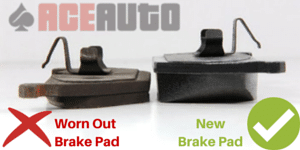 Worn Brake Pads
Worn Brake Pads
Most cars use what are known as disc brakes. A hydraulic system filled with brake fluid triggers a set of pads that clamp down on the cars calipers, which causes them to squeeze together on a disc known as the rotor. The friction that occurs between the pads and rotor eventually stops the car. Over time, as you can imagine, the pads will begin to wear thin, which means they'll become less effective at slowing and stopping your car. To check the thickness of your brake pads, all you need to do is look between the spokes of your wheel to spot the shiny metal rotor inside. When you find it, look around the outer edge where you'll see the metal caliper. Between the caliper and rotor, you'll see the pad. You'll have to estimate, but generally, your pads should be at least one-quarter of an inch thick. If they're any thinner than that, it's a good idea to get them changed. If your car wheel isn't designed in such a way that you can see through the spokes, you'll have to remove the tire to see the rotor and pads. In either case, while you're looking, it's also a good idea to inspect the rotor itself. It should be relatively smooth. If you see any deep grooves or pits, it might also be time to replace that, as well.
Strange Sounds
 One of the warning signs that your brakes need servicing can come from a small indicator in your braking system that emits a high-pitched squeal when your pads need replacing. In addition to the squeal from the sensor, you'll also want to listen for a harsh grinding sound. This means that you've gone completely through your brake pads and now, when you apply the brakes, the metal of the calipers is grinding against the metal of your rotors. Not only is this an ineffective way to stop your car, chances are good that you'll also damage your rotors, thus turning a relatively easy and inexpensive pad job, into a more costly rotor resurfacing or replacement ordeal. Remember each brake pad comes equipped with a wear indicator that squeals when your pads need replacing.
One of the warning signs that your brakes need servicing can come from a small indicator in your braking system that emits a high-pitched squeal when your pads need replacing. In addition to the squeal from the sensor, you'll also want to listen for a harsh grinding sound. This means that you've gone completely through your brake pads and now, when you apply the brakes, the metal of the calipers is grinding against the metal of your rotors. Not only is this an ineffective way to stop your car, chances are good that you'll also damage your rotors, thus turning a relatively easy and inexpensive pad job, into a more costly rotor resurfacing or replacement ordeal. Remember each brake pad comes equipped with a wear indicator that squeals when your pads need replacing.
Pulling
 Has your car ever felt like your car has a mind of its own? As if it wants to make right or left hand turns while driving or braking? If so, this could indicate a problem with the braking system. The cause of this pulling might be a stuck caliper. Because such a scenario would cause friction on one wheel and not the others, your car can pull to the side where the caliper is stuck. Two other brake-related scenarios that could cause a car to pull would be a collapsed brake hose that would cause your calipers to move unevenly when applying the brakes, or uneven brake pads, which would also apply different amounts of pressure to different wheels. Pulling, however, doesn't always indicate a problem with the brakes. The cause could also come from unevenly inflated or worn tires, poor alignment or a problem with your vehicle's suspension. This is why, if your car begins to pull, you may want to pull up to the Ace Auto Repair and have our ASE technician do a full checkup on the problem.
Has your car ever felt like your car has a mind of its own? As if it wants to make right or left hand turns while driving or braking? If so, this could indicate a problem with the braking system. The cause of this pulling might be a stuck caliper. Because such a scenario would cause friction on one wheel and not the others, your car can pull to the side where the caliper is stuck. Two other brake-related scenarios that could cause a car to pull would be a collapsed brake hose that would cause your calipers to move unevenly when applying the brakes, or uneven brake pads, which would also apply different amounts of pressure to different wheels. Pulling, however, doesn't always indicate a problem with the brakes. The cause could also come from unevenly inflated or worn tires, poor alignment or a problem with your vehicle's suspension. This is why, if your car begins to pull, you may want to pull up to the Ace Auto Repair and have our ASE technician do a full checkup on the problem.
Vibrations
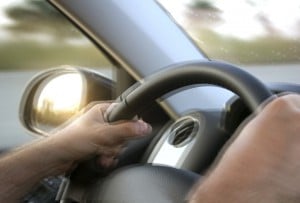 If your brake pedal pulses under normal braking circumstances, you could have a problem. Generally, a vibrating brake pedal indicates warped rotors. Their uneven surfaces will thrum against the brake pads, and you'll feel the feedback through the brake pedal. Rotors usually only warp when they're under extreme stress for an extended period. The friction-generated heat caused by driving down steep mountainsides or by stopping frequently while towing something heavy, can cause the metal of the rotors to change shape. If you haven't stressed your brakes recently, but you still feel vibration in the pedal, it may be best to take it in for a diagnostic test.
If your brake pedal pulses under normal braking circumstances, you could have a problem. Generally, a vibrating brake pedal indicates warped rotors. Their uneven surfaces will thrum against the brake pads, and you'll feel the feedback through the brake pedal. Rotors usually only warp when they're under extreme stress for an extended period. The friction-generated heat caused by driving down steep mountainsides or by stopping frequently while towing something heavy, can cause the metal of the rotors to change shape. If you haven't stressed your brakes recently, but you still feel vibration in the pedal, it may be best to take it in for a diagnostic test.
Temperamental Pedal
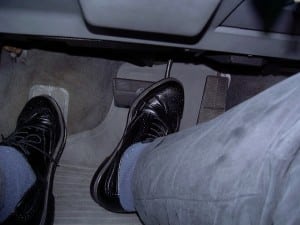 In addition to thrumming, your brake pedal can give you other indications that your car's braking system might need examining. A mushy pedal, one that goes practically to the floor before engaging the brakes, could indicate worn pads or a problem with the hydraulic system, such as air in the line, an air leak, or a brake fluid leak. To check for a fluid leak, put an old white sheet or piece of light cardboard under the car overnight. In the morning, examine any fluid that collects. Brake fluid will be practically clear and the consistency of cooking oil. The opposite of a mushy pedal is one that causes the brakes to grab immediately at the slightest touch. This could indicate an unevenly worn rotor, dirty brake fluid, or contamination of the fluid by moisture. You can solve such a problem with a relatively inexpensive change of fluid.
In addition to thrumming, your brake pedal can give you other indications that your car's braking system might need examining. A mushy pedal, one that goes practically to the floor before engaging the brakes, could indicate worn pads or a problem with the hydraulic system, such as air in the line, an air leak, or a brake fluid leak. To check for a fluid leak, put an old white sheet or piece of light cardboard under the car overnight. In the morning, examine any fluid that collects. Brake fluid will be practically clear and the consistency of cooking oil. The opposite of a mushy pedal is one that causes the brakes to grab immediately at the slightest touch. This could indicate an unevenly worn rotor, dirty brake fluid, or contamination of the fluid by moisture. You can solve such a problem with a relatively inexpensive change of fluid.
West Jordan Automotive Brake Repair
If you are experiencing issues with your car or trucks brakes, visit to Ace Auto Repair Utah for a diagnostic check. We guarantee all of our work and promise to get your vehicle up and running in no time. Call 801-803-6016 or visit us online at AceAutoUtah.com.





 Worn Brake Pads
Worn Brake Pads One of the
One of the  Has your car ever felt like your car has a mind of its own? As if it wants to make right or left hand turns while driving or braking? If so, this could indicate a problem with the braking system. The cause of this pulling might be a stuck caliper. Because such a scenario would cause friction on one wheel and not the others, your car can pull to the side where the caliper is stuck. Two other brake-related scenarios that could cause a car to pull would be a collapsed brake hose that would cause your calipers to move unevenly when applying the brakes, or uneven brake pads, which would also apply different amounts of pressure to different wheels. Pulling, however, doesn't always indicate a problem with the brakes. The cause could also come from unevenly inflated or worn tires, poor alignment or a problem with your vehicle's suspension. This is why, if your car begins to pull, you may want to pull up to the Ace Auto Repair and have our ASE technician do a full checkup on the problem.
Has your car ever felt like your car has a mind of its own? As if it wants to make right or left hand turns while driving or braking? If so, this could indicate a problem with the braking system. The cause of this pulling might be a stuck caliper. Because such a scenario would cause friction on one wheel and not the others, your car can pull to the side where the caliper is stuck. Two other brake-related scenarios that could cause a car to pull would be a collapsed brake hose that would cause your calipers to move unevenly when applying the brakes, or uneven brake pads, which would also apply different amounts of pressure to different wheels. Pulling, however, doesn't always indicate a problem with the brakes. The cause could also come from unevenly inflated or worn tires, poor alignment or a problem with your vehicle's suspension. This is why, if your car begins to pull, you may want to pull up to the Ace Auto Repair and have our ASE technician do a full checkup on the problem. If your
If your  In addition to thrumming, your brake pedal can give you other indications that your car's braking system might need examining. A mushy pedal, one that goes practically to the floor before engaging the brakes, could indicate worn pads or a problem with the hydraulic system, such as air in the line, an air leak, or a brake fluid leak. To check for a fluid leak, put an old white sheet or piece of light cardboard under the car overnight. In the morning, examine any fluid that collects. Brake fluid will be practically clear and the consistency of cooking oil. The opposite of a mushy pedal is one that causes the brakes to grab immediately at the slightest touch. This could indicate an unevenly worn rotor, dirty brake fluid, or contamination of the fluid by moisture. You can solve such a problem with a relatively inexpensive change of fluid.
In addition to thrumming, your brake pedal can give you other indications that your car's braking system might need examining. A mushy pedal, one that goes practically to the floor before engaging the brakes, could indicate worn pads or a problem with the hydraulic system, such as air in the line, an air leak, or a brake fluid leak. To check for a fluid leak, put an old white sheet or piece of light cardboard under the car overnight. In the morning, examine any fluid that collects. Brake fluid will be practically clear and the consistency of cooking oil. The opposite of a mushy pedal is one that causes the brakes to grab immediately at the slightest touch. This could indicate an unevenly worn rotor, dirty brake fluid, or contamination of the fluid by moisture. You can solve such a problem with a relatively inexpensive change of fluid.


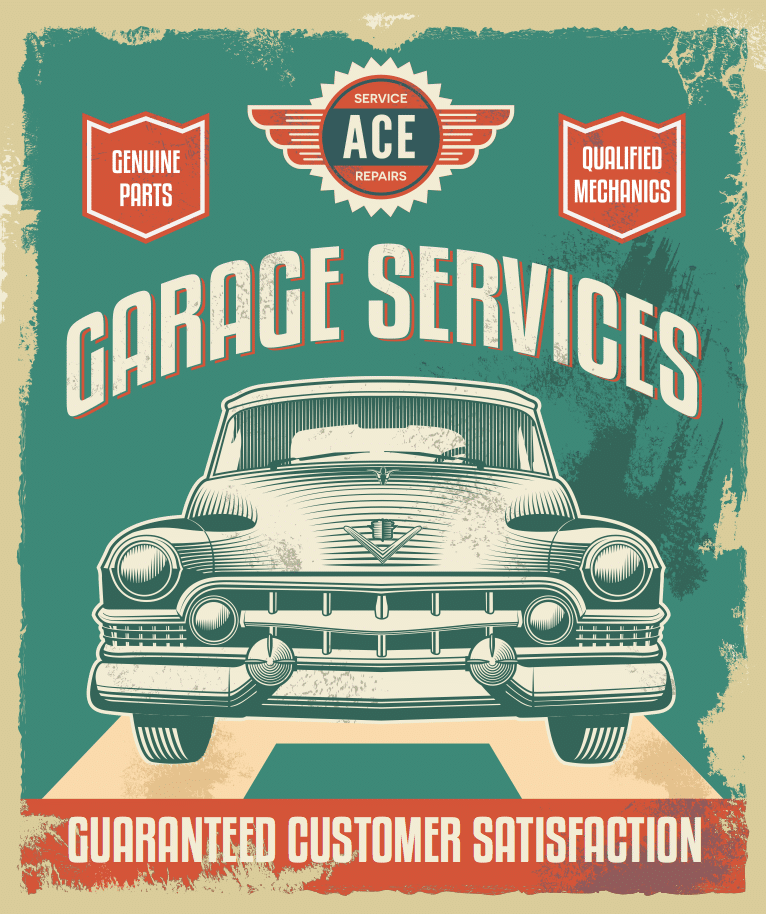


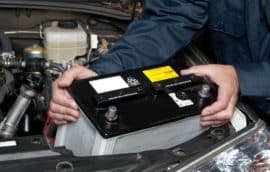
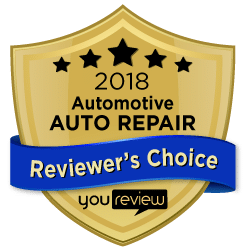
 Ace Auto Repair
Ace Auto Repair
Recent Comments